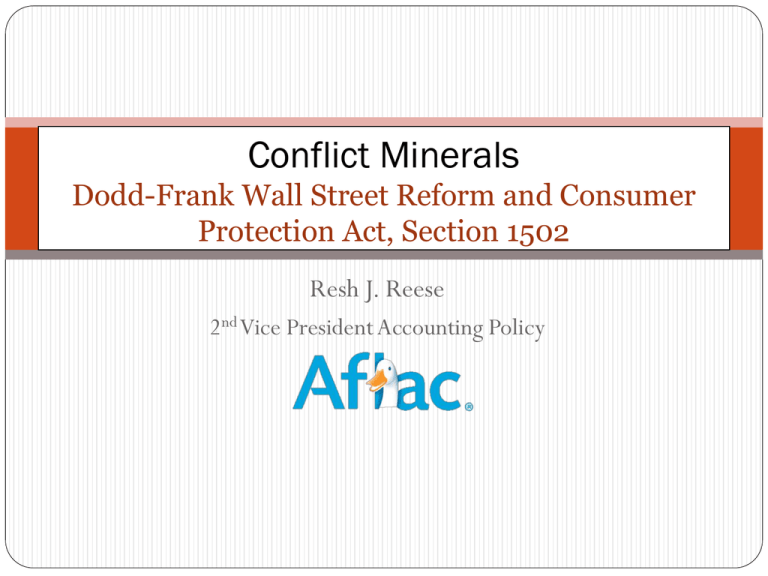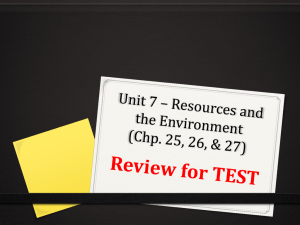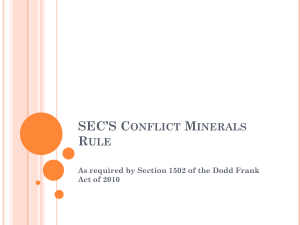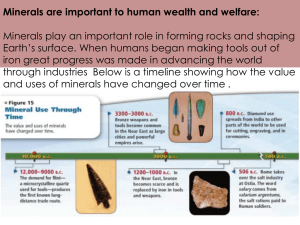Conflict Minerals
advertisement

Conflict Minerals Dodd-Frank Wall Street Reform and Consumer Protection Act, Section 1502 Resh J. Reese 2nd Vice President Accounting Policy 1 Background Section 1502 of Dodd-Frank Act SEC issued final rules on August 22, 2012 Calendar year reporting period (regardless of fiscal year) First report on Form SD due May 31, 2014 2 What are Conflict Minerals? Cassiterite Columbite-tantalite (coltan) Wolframite Derivatives of the above (the “3Ts”): Tin Tantalum Tungsten Gold 3 What are Conflict Minerals? Regardless of origin No de minimus exception Example: Dyes with infinitesimal amounts of tungsten? Exclusions for: Minerals outside supply chain prior to 1/1/13 Minerals from recycled or scrap sources 4 Who Must Comply? Reporting companies (Exchange Act Sections 13(a) and 15(d)) SEC estimates approximately 6,000 reporting companies impacted Legal challenge by NAM 5 Compliance Process SEC’s three-step process: Step 1: Does the company use conflict minerals? Applicability assessment and supply chain readiness Step 2: Determine country of origin of the minerals Reasonable country of origin inquiry (RCOI) and due diligence Step 3: Conduct supply chain due diligence Reporting: Form SD 6 Step 1: Use of Conflict Minerals Does the company manufacture or contract to manufacture products? Assembling the product out of components not in raw material form “Contract to manufacture” – degree of influence over the materials, parts, ingredients or components “Product” – the soft drink or the soft drink including the can? Are conflict minerals necessary to the functionality or production of the product? “Primary purpose” - Gold pendant hanging from a necklace vs. gold buckle on pair of shoes Trace amounts of tin in steel Computers and power lines 7 Step 1: Compliance enterprise-wide effort Cross-Functional Team: Procurement/supply chain/sourcing Product design/engineering Compliance/legal Sustainability/environmental Finance/CFO/controller IT back office support Internal Audit Marketing/communications and investor relations 8 Step 1: Assessment of supply chain Key activities: Form cross-functional team and empower the team leader Set up governance structure, develop a charter, work plan, timeline, budgets Send internal communication and conduct training sessions Identify data sources, software tools and resources Engage management to assess targets and timelines Draft conflict minerals policy Agree to supplier engagement strategy Perform risk prioritization Develop risk management and corrective action plan 9 Step 2: Country of Origin Reasonable Country of Origin Inquiry (RCOI) DRC and adjoining countries Supplier representations Conflict Minerals Policy 10 Step 2: Reasonable country of origin inquiry (RCOI) Key activities: Determine if RCOI only is possible, or move to due diligence Conduct data mining to identify supplier base Prioritize tier 1 suppliers based on risk Engage suppliers with conflict minerals reporting template Validate supplier responses Implement supplier risk management plan Monitor and track performance of supplier and risk mitigation efforts 11 Step 3: SC Due Diligence Based on RCOI, company knows (or has reason to believe) that its conflict minerals originated in a covered country and did not come from recycled sources Due diligence on the source using recognized due diligence framework (OECD) Based on due diligence, if company determines conflict minerals did not originate from covered country or did come from recycled or scrap sources, then: File Form SD Disclose information on company website 12 Step 3 (cont.) If any other conclusion, include with Form SD: Conflict Minerals Report Independent private sector audit Exception from audit requirement (2 years for large companies): Include description of products “DRC conflict undeterminable” in Conflict Minerals Report 13 Step 3 Reporting Key activities: Summarize results of RCOI/Due Diligence Engage independent auditor (if applicable) Prepare Form SD and Conflict Minerals Report as an attachment to Form SD (filed annually) Conduct independent audit of conflict minerals report in accordance with the criteria set forth in the rule File forms with SEC by reporting deadline 14 Step 3: Independent Audit Companies need to keep the audit in mind throughout the process While the rule does not require reviewable business records, maintenance of appropriate records may be useful in demonstrating compliance with the final rule Companies that expect to have completed Due Diligence for a portion of their products will undertake an audit as soon as the 2013 reporting year Must be in accordance with Government Auditing Standards The audit will assess whether the design of the due diligence activities conforms in all material aspects to the due diligence framework selected by the organization, as well as whether the description of the due diligence measures is consistent with the process undertaken Will not assess effectiveness of the due diligence or the appropriateness of the conclusions whether products are DRC conflict free 15 Step 3 (cont) Independent Audit 16 The audit does not opine on your conclusions regarding conflict minerals. or the effectiveness of your due diligence Attest examination with an opinion (must be a CPA) or a performance audit with a conclusion (may be performed by a CPA or a non CPA) Audit may be performed by financial statement auditor, subject to audit committee pre approval and reporting related fees in “Other” Due diligence work plans include performing an audit readiness assessment START: Does issuer file reports with the SEC? Does issuer manufacture, or contract to manufacture, the product? YES Are conflict minerals necessary to the functionality or product? YES Were the conflict minerals outside the supply chain prior to 1/31/2013? NO NO Rule does not apply. END Complete Steps 2-3 File SEC Form SD Key Take-Aways Public Relations: Results of this filing will ultimately affect public opinion Corporate responsibility initiatives and green initiative analysts ratings Ranking of suppliers Regulatory: If entity does not file a Form SD and the SEC determines that we were incorrect in analysis could risk losing S-3 eligibility. Being S-3 eligible means that we have special privileges with the SEC when it comes to raising debt (i.e. outstanding shelf registration statement on file and can very quickly raise debt by filing a supplement). It could also lead to issues regarding currently outstanding debt, securities offered under employee benefit plans and a potential delinquency notice from the NYSE. Example of policy Philips’ position on responsible sourcing in relation to Conflict Minerals http://www.philips.com/about/company/businesses/suppliers/conflict_minerals.page “The proceeds from harmful social and environmental practices in mines, especially in the eastern provinces of the Democratic Republic of Congo (DRC), have been used to fuel armed conflict in the region. This is a major concern to the electronics industry, among others. The recently enacted Dodd Frank law in the United States defines conflict minerals as Tin, Tungsten, Tantalum and Gold (3TG) and any derivatives thereof. Our commitment to sustainable development compels us to address this concern, even though Philips does not directly source minerals from the DRC and the mines are typically seven or more tiers removed from our direct suppliers. Philips has committed not to purchase raw materials, subassemblies, or supplies which we know contain conflict minerals that directly or indirectly finance or benefit armed groups in the DRC or an adjoining country. We have requested our relevant suppliers to confirm that they provide only conflict-free minerals to Philips. While those suppliers have stated that indeed, to their knowledge, they have provided us with conflict-free minerals, we nevertheless recognize that our suppliers may have too limited insight into their supply chains to fully understand the origin of the minerals. Due to the size of our supply chain as well as the complexity of the routes by which these conflict minerals are traded, smelted, recycled, and sold (including the common practice of mixing ores and recycled scrap from many different sources), Philips and its suppliers face a huge challenge to obtain – for all minerals - full traceability to exact origin with a high degree of certainty.” 19 Industry Responses Regulation is final. Manufacturers have begun determining the impact and issues Law suits have been filed: American Petroleum Institute National Association of Manufacturers, US Chamber of Commerce and Business Roundtable 20 21 21








